A Model for Assessing Pedestrian Corridors. Application to Vitoria-Gasteiz City (Spain)
Abstract
:1. Introduction
2. Methodology for the Assessment of the Implementation of Pedestrian Corridors
2.1. Creation of Network Analysis Database
2.2. Definition of Scenarios
2.3. Calculation of Pedestrian Routes
2.4. Identification of Pedestrian Corridors
2.5. Comparison of Scenarios
2.6. Validation Using Control Scenarios
3. Application to the Case Study
3.1. Description of the Study Area
3.2. Assessment of the Implementation of Pedestrian Corridors
3.2.1. Creation of Network Analysis Database
3.2.2. Definition of Scenarios
3.2.3. Calculation of Pedestrian Routes
3.2.4. Identification of Pedestrian Corridors
3.2.5. Results: Comparison of Scenarios
3.2.6. Validation of Results with Control Scenarios
4. Discussion
5. Conclusions
Acknowledgments
Author Contributions
Conflicts of Interest
References
- United Nations, Department of Economic and Social Affairs. World Urbanization Prospects; The 2014 Revision; United Nations: New York, NY, USA, 2015. [Google Scholar]
- International Transport Forum. Pedestrian Safety, Urban Space and Health; Organisation for Economic Co-Operation and Development (OECD): Paris, France, 2012. [Google Scholar]
- Tournier, I.; Dommes, A.; Cavallo, V. Review of safety and mobility issues among older pedestrians. Accid. Anal. Prev. 2016, 91, 24–35. [Google Scholar] [CrossRef] [PubMed]
- Litman, T. Measuring transportation: Traffic, mobility and accessibility. ITE J. 2003, 73, 28–32. [Google Scholar]
- Gatrell, A. Therapeutic mobilities: Walking and “steps” to well being and health. Health Place 2013, 22, 98–106. [Google Scholar] [CrossRef] [PubMed]
- Wood, L.; Frank, L.; Giles-Corti, B. Sense of community and its relationship with walking and neighborhood design. Soc. Sci. Med. 2010, 70, 1381–1390. [Google Scholar] [CrossRef] [PubMed]
- Van Dyck, D.; Deforche, B.; Cardon, G.; de Bourdeaudhuij, I. Neighbourhood walkability and its particular importance for adults with a preference for passive transport. Health Place 2009, 15, 496–504. [Google Scholar] [CrossRef] [PubMed]
- Speck, J. Walkable City: How Downtown Can Save America, One Step at a Time; Farrar, Straus and Giroux: New York, NY, USA, 2012. [Google Scholar]
- Kim, H.; Macdonald, E. Does Wind Discourage Sustainable Transportation Mode Choice? Findings from San Francisco, California, USA. Sustainability 2016, 8, 257. [Google Scholar] [CrossRef]
- Joh, K.; Chakrabarti, S.; Boarnet, M.G.; Woo, A. The Walking Renaissance: A Longitudinal Analysis of Walking Travel in the Greater Los Angeles Area, USA. Sustainability 2015, 7, 8985–9011. [Google Scholar] [CrossRef]
- European Commission. WHITE PAPER Roadmap to a Single European Transport Area—Towards a Competitive and Resource Efficient Transport System; Publications Office of the European Union: Luxembourg, 2011. [Google Scholar]
- Van de Camp, W. Report on the Implementation of the 2011 White Paper on Transport: Taking Stock and the Way Forward towards Sustainable Mobility; (2015/2005(INI)). Available online: http://www.europarl.europa.eu/sides/getDoc.do?pubRef=-//EP//NONSGML+REPORT+A8-2015-0246+0+DOC+PDF+V0//EN (accessed on 15 March 2017).
- Foltete, J.; Piombini, A. Urban layout, landscape features and pedestrian usage. Landsc. Urban Plan. 2007, 81, 225–234. [Google Scholar] [CrossRef]
- Özbil, A.; Peponis, J. The Effects of Urban Form on Walking to Transit. In Proceedings of the Eighth International Space Syntax Symposium, Santiago de Chile, Chile, 3–6 January 2012.
- García-Palomares, J. Urban sprawl and travel to work: The case of the metropolitan area of Madrid. J. Transp. Geogr. 2010, 18, 197–213. [Google Scholar] [CrossRef]
- Peponis, J.; Bafna, S.; Zhang, Z. The connectivity of streets: Reach and directional distance. Environ. Plan. B Plan. Des. 2008, 35, 881–901. [Google Scholar] [CrossRef]
- Yu, C. Built Environmental Designs in Promoting Pedestrian Safety. Sustainability 2015, 7, 9444–9460. [Google Scholar] [CrossRef]
- You, H. Quantifying Urban Fragmentation under Economic Transition in Shanghai City, China. Sustainability 2016, 8, 21. [Google Scholar] [CrossRef]
- Rotem-Mindali, O. Retail fragmentation vs. urban livability: Applying ecological methods in urban. Appl. Geogr. 2012, 35, 292–299. [Google Scholar] [CrossRef]
- Ortega, E.; Martín, B.; Nuñez, E.; Ezquerra, A. Urban fragmentation map of the Chamberí district in Madrid. J. Maps 2014, 11, 788–797. [Google Scholar] [CrossRef]
- Victoria Transport Policy Institute. Online TDM Encyclopedia. Available online: http://www.vtpi.org/tdm/index.php (accessed on 25 September 2016).
- Randall, T.; Baetz, B. Evaluating Pedestrian Connectivity for Suburban Sustainability. J. Urban Plan. 2001, 127, 1–15. [Google Scholar] [CrossRef]
- Southworth, M. Designing the Walkable City. J. Urban Plan. 2005, 131, 246–257. [Google Scholar] [CrossRef]
- Pikora, T.; Giles-Corti, B.; Bull, F.; Jamrozik, K.; Donovan, R. Developing a framework for assessment of the environmental determinants of walking and cycling. Soc. Sci. Med. 2003, 56, 1693–1703. [Google Scholar] [CrossRef]
- Krizek, K.J.; Horning, J.; El-Geneidy, A.M. Perceptions of Accessibility to Neighborhood Retail and Other Public Services. In Accessibility and Transport Planning: Challenges for Europe and North America; Geurs, K., Krizek, K., Reggiani, A., Eds.; Edward Elgar: London, UK, 2012; pp. 96–117. [Google Scholar]
- Nourian, P.; Hoeven, F.; Rezvani, S.; Sariylidiz, S. Easiest paths for walking and cycling: Combining syntactic and geographic analyses in studying walking and cycling mobility. In Proceedings of the 10th International Space Syntax Symposium, London, UK, 13–17 July 2015.
- Sevtsuk, A.; Mekonnen, M. Urban network analysis: A new toolbox for ArcGIS. Rev. Int. Géomat. 2012, 2, 287–305. [Google Scholar] [CrossRef]
- Hillier, B.; Penn, A.; Grajewski, T.; Xu, J. Natural Movement: Or, Configuration and Attraction in Urban Pedestrian Movement. Environ. Plan. B Plan. Des. 1993, 20, 29–66. [Google Scholar] [CrossRef]
- Radford, N.; Ragland, D. Space Syntax: Innovative Pedestrian Volume Modeling Tool for Pedestrian Safety. Transp. Res. Rec. 2004, 1878, 66–74. [Google Scholar] [CrossRef]
- Chang, D.; Penn, A. Integrated multilevel circulation in dense urban areas: The effect of multiple interacting constraints on the use of complex urban areas. Environ. Plan. B Plan. Des. 1998, 25, 507–538. [Google Scholar] [CrossRef]
- Peponis, J.; Ross, C.; Rashid, M. The structure of urban space, movement and co-presence: The case of Atlanta. Geoforum 1997, 28, 341–358. [Google Scholar] [CrossRef]
- Chang, D. Spatial Choice and Preference in Multilevel Movement Networks. Environ. Behav. 2002, 34, 582–615. [Google Scholar] [CrossRef]
- Marinescu, I.; Avram, S. Evaluation of urban fragmentation in Craiova city, Romania. Procedia Environ. Sci. 2012, 14, 207–215. [Google Scholar] [CrossRef]
- Fan, C.; Myint, S. A comparison of spatial autocorrelation indices and landscape metrics in measuring urban landscape fragmentation. Landsc. Urban Plan. 2014, 121, 117–128. [Google Scholar] [CrossRef]
- Kane, K.; Connors, J.; Galletti, C. Beyond fragmentation at the fringe: A path-dependent, high-resolution analysis of urban land cover in Phoenix, Arizona. Appl. Geogr. 2014, 142, 123–134. [Google Scholar] [CrossRef]
- Soria-Lara, J.; Aguilera-Benavente, F.; Arranz-López, A. Integrating land use and transport practice through spatial. Transp. Res. Part A Policy Pract. 2016, 91, 330–345. [Google Scholar] [CrossRef]
- Chetkiewicz, C.L.; St. Claire, C.; Boyce, M. Corridors for Conservation: Integrating Pattern and Process. Annu. Rev. Ecol. Evol. Syst. 2006, 37, 317–342. [Google Scholar] [CrossRef]
- Beier, P.; Noss, R. Do Habitat Corridors Provide Connectivity? Conserv. Biol. 1998, 12, 1241–1252. [Google Scholar] [CrossRef]
- Brodie, J.F.; Giordano, A.J.; Dickson, B.; Hebblewhite, M.; Bernard, H.; Mohd-Azlan, J.; Anderson, J.; Ambu, L. Evaluating Multispecies Landscape Connectivity in a Threatened Tropical Mammal Community. Conserv. Biol. 2015, 29, 1–11. [Google Scholar] [CrossRef] [PubMed]
- Dutta, T.; Sharma, S.; McRae, B.H.; Sarathi Roy, P.; DeFries, R. Connecting the dots: Mapping habitat connectivity for tigers. Reg. Environ. Chang. 2016, 16, 53–67. [Google Scholar] [CrossRef]
- Hortal, L.; Saura, S. Comparison and development of new graph-based landscape connectivity indices: Towards the priorization of habitat patches and corridors for conservation. Landsc. Ecol. 2006, 21, 959–967. [Google Scholar] [CrossRef]
- Kong, F.; Yin, H.; Nakagoshi, N.; Zong, Y. Urban green space network development for biodiversity conservation: Identification based on graph theory and gravity modeling. Landsc. Urban Plan. 2010, 95, 16–27. [Google Scholar] [CrossRef]
- Pinto, N.; Keitt, T. Beyond the least-cost path: Evaluating corridor redundancy using a graph-theoretic approach. Landsc. Ecol. 2007, 24, 253–266. [Google Scholar] [CrossRef]
- Drielsma, M.; Manion, G.; Ferrier, S. The spatial links tool: Automated mapping of habitat linkages in variegated landscapes. Ecol. Model. 2007, 200, 403–411. [Google Scholar] [CrossRef]
- Adriaensen, F.; Chardon, J.P.; De Blust, G.; Swinnen, E.; Villalba, S.; Gulinck, S.; Matthysen, E. The application of “least-cost” modelling as a functional landscape model. Landsc. Urban Plan. 2003, 64, 233–247. [Google Scholar] [CrossRef]
- Mancebo, S.; Ramos, B.; Casermeiro, M.; Otero, I. A model for assessing habitat fragmentation caused by new infrastructures in extensive territories. Evaluation of the impact of the Spanish Infrastructure and Transport Plan. J. Environ. Manag. 2010, 91, 1087–1096. [Google Scholar] [CrossRef] [PubMed]
- Compton, B.; McGarigal, K.; Cushman, S.; Gamble, L. A Resistant-Kernel Model of Connectivity for Amphibians that Breed in Vernal Pools. Conserv. Biol. 2007, 21, 788–799. [Google Scholar] [CrossRef] [PubMed]
- Cushman, S.; Elliot, N.; Macdonald, D.; Loveridge, A. A multi-scale assessment of population connectivity in African lions (Panthera leo) in response to landscape change. Landsc. Ecol. 2016, 31, 1337–1353. [Google Scholar] [CrossRef]
- Teng, M.; Wu, C.; Zhou, Z.; Lord, L.; Zheng, Z. Multipurpose greenway planning for changing cities: A framework integrating priorities and a least-cost path model. Landsc. Urban Plan. 2011, 103, 1–14. [Google Scholar]
- Havard, C.; Willis, A. Effects of installing a marked crosswalk on road crossing behaviour and perceptions of the environment. Transp. Res. Part F Traffic Psychol. Behav. 2011, 15, 249–260. [Google Scholar] [CrossRef]
- Li, M.; Alhajyaseen, W.; Nakamura, H. A traffic Signal Optimization Strategy Considering Both Vehicular and Pedestrian Flows. In Proceedings of the 89th Annual Meeting of the Transportation Research Board, Washington, DC, USA, 10–14 January 2010.
- Rodriguez, D.; Joo, J. The relationship between non-motorized mode choice and the local physical environment. Transp. Res. Part D Transp. Environ. 2004, 9, 151–173. [Google Scholar] [CrossRef]
- ESRI. ArcGIS Network Analyst. 2016. Available online: http://www.esri.com/software/arcgis/extensions/networkanalyst (accessed on 28 September 2016).
- Dijkstra, E. A note on two problems in connexion with graphs. Numer. Math. 1959, 1, 269–271. [Google Scholar] [CrossRef]
- ESRI. ArcGIS Kernel Density. 2016. Available online: http://pro.arcgis.com/en/pro-app/tool-reference/spatial-analyst/kernel-density.htm (accessed on 22 October 2016).
- Silverman, B.W. Density Estimation for Statistics and Data Analysis; Chapman and Hall: New York, NY, USA, 1986. [Google Scholar]
- Jenks, G.F.; Caspall, F. Error on choroplethic maps: Definition, measurement, reduction. Ann. Assoc. Am. Geogr. 1971, 61, 217–244. [Google Scholar] [CrossRef]
- Xie, Z.; Yan, J. Kernel Density Estimation of traffic accidents in a network space. Comput. Environ. Urban Syst. 2008, 32, 396–406. [Google Scholar] [CrossRef]
- Okabe, A.; Satoh, T.; Sugihara, K. A kernel density estimation method for networks, its computational method and a GIS-based tool. Int. J. Geogr. Inf. Sci. 2009, 23, 7–23. [Google Scholar] [CrossRef]
- Tanga, L.; Kana, Z.; Zhangb, X.; Suna, F.; Yanga, X.; Lia, Q. A network Kernel Density Estimation for linear features in space-time analysis of big trace data. Int. J. Geogr. Inf. Sci. 2016, 30, 1717–1737. [Google Scholar] [CrossRef]
- TRANSyT. Análisis de los Resultados de la Encuesta de Movilidad 2014 de Vitoria-Gasteiz Realizada por TRANSyT (Universidad Politécnica de Madrid) Para el Centro de Estudios Ambientales; Centro de Estudios Ambientales: Vitoria-Gasteiz, Spain, 2014. (In Spanish) [Google Scholar]
- Council of Vitoria-Gasteiz. Mobility and Public Space Plan (Plan de Movilidad y Espacio Público de Vitoria-Gasteiz); Council of Vitoria-Gasteiz: Vitoria-Gasteiz, Spain, 2007. (In Spanish) [Google Scholar]
- BCNECOLOGIA. BCNECOLOGIA Supermanzanas. Available online: http://www.bcnecologia.net/es/modelo-conceptual/supermanzana (accessed on 28 September 2016).
- OSM Contributors. Available online: http://planet.openstreetmap.org (accessed on 8 October 2016).
- Muñoz-Lopez, B. Integrating Bicycle Option in Mode Choice Models through Latent Variables. Ph.D. Thesis, Escuela Tecnica Superior de Ingenieros de Caminos, Canales y Puertos, Madrid, Spain, 2016. [Google Scholar]
- Tobler, W. Three Presentations on Geographical Analysis and Modeling: Non-Isotropic Geographical Modeling Speculations on the Geometry of Geography Global Spatial Analysis; National Center for Geographic Information and Analysis: Santa Barbara, CA, USA, 1993. [Google Scholar]
- Gates, T.; Noyce, D.; Bill, A.; van Ee, N. Recommended walking speeds for pedestrian clearance timing based on pedestrian characteristics. Transp. Res. Rec. 2006, 1982, 38–47. [Google Scholar] [CrossRef]
- Lei, T.L.; Church, R.L. Mapping transit-based access: Integrating GIS, routes and schedules. Int. J. Geogr. Inf. Sci. 2010, 24, 283–304. [Google Scholar] [CrossRef]
- Noland, R.B. Pedestrian Travel Times and Motor Vehicle Traffic Signals. Transp. Res. Rec. 1996, 1553, 28–33. [Google Scholar] [CrossRef]
- O’ Sullivan, D.; Morrison, A.; Shearer, J. Using desktop GIS for the investigation of accessibility by public transport: An isochrone approach. Int. J. Geogr. Inf. Sci. 2000, 14, 85–104. [Google Scholar] [CrossRef]
- Hsiao, S.; Lu, J.; Sterling, J.; Weatherford, M. Use of Geographic Information System for Analysis of Transit Pedestrian Access. Transp. Res. Rec. 1997, 1604, 50–59. [Google Scholar] [CrossRef]
- Zhao, F.; Chow, L.F.; Li, M.-T.; Gan, A. Forecasting Transit Walk Accessibility: Regression Model Alternative to Buffer Method. Transp. Res. Rec. 2003, 1835, 34–41. [Google Scholar] [CrossRef]
- Kimpel, T.J.; Dueker, K.J.; El-Geneidy, A.M. Using GIS to Measure the Effect of Overlapping Service Areas on Passenger Boardings at Bus Stops. URISA J. 2007, 19, 5–11. [Google Scholar]
- Gutiérrez, J.; Garcia-Palomares, J.C. Distance-measure impacts on the calculation of transport service areas using GIS. Environ. Plan. B Plan. Des. 2008, 35, 480–503. [Google Scholar] [CrossRef]
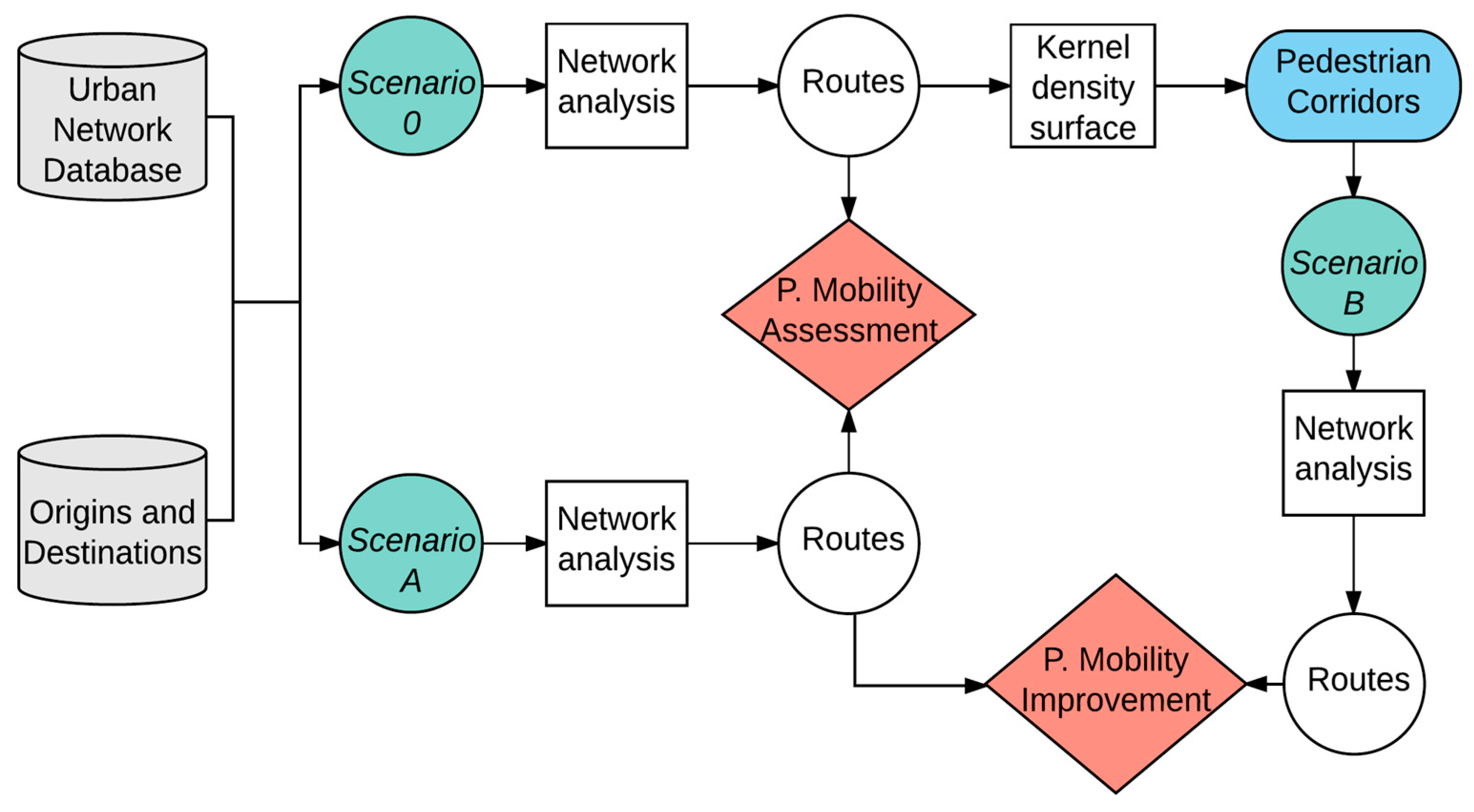
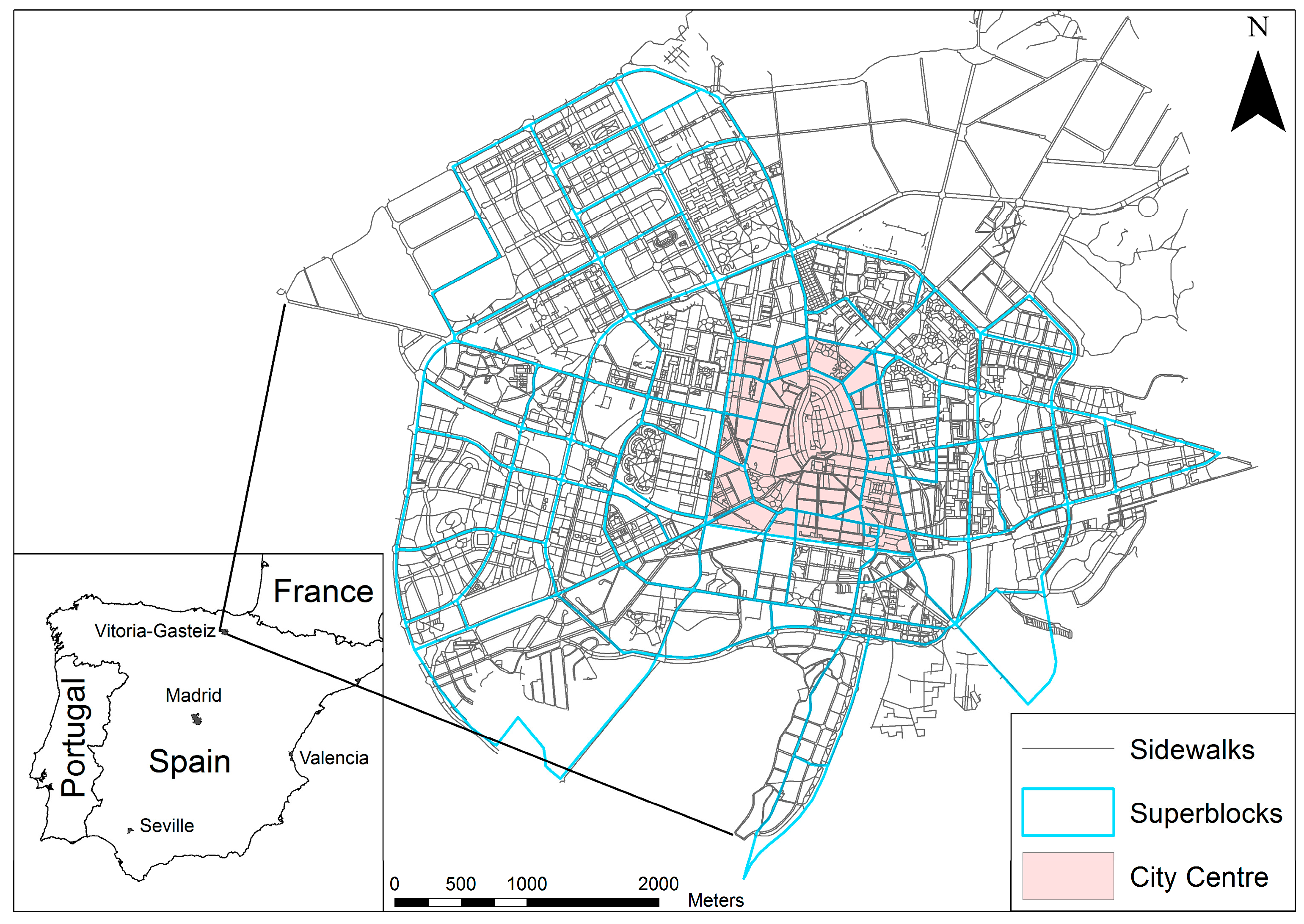
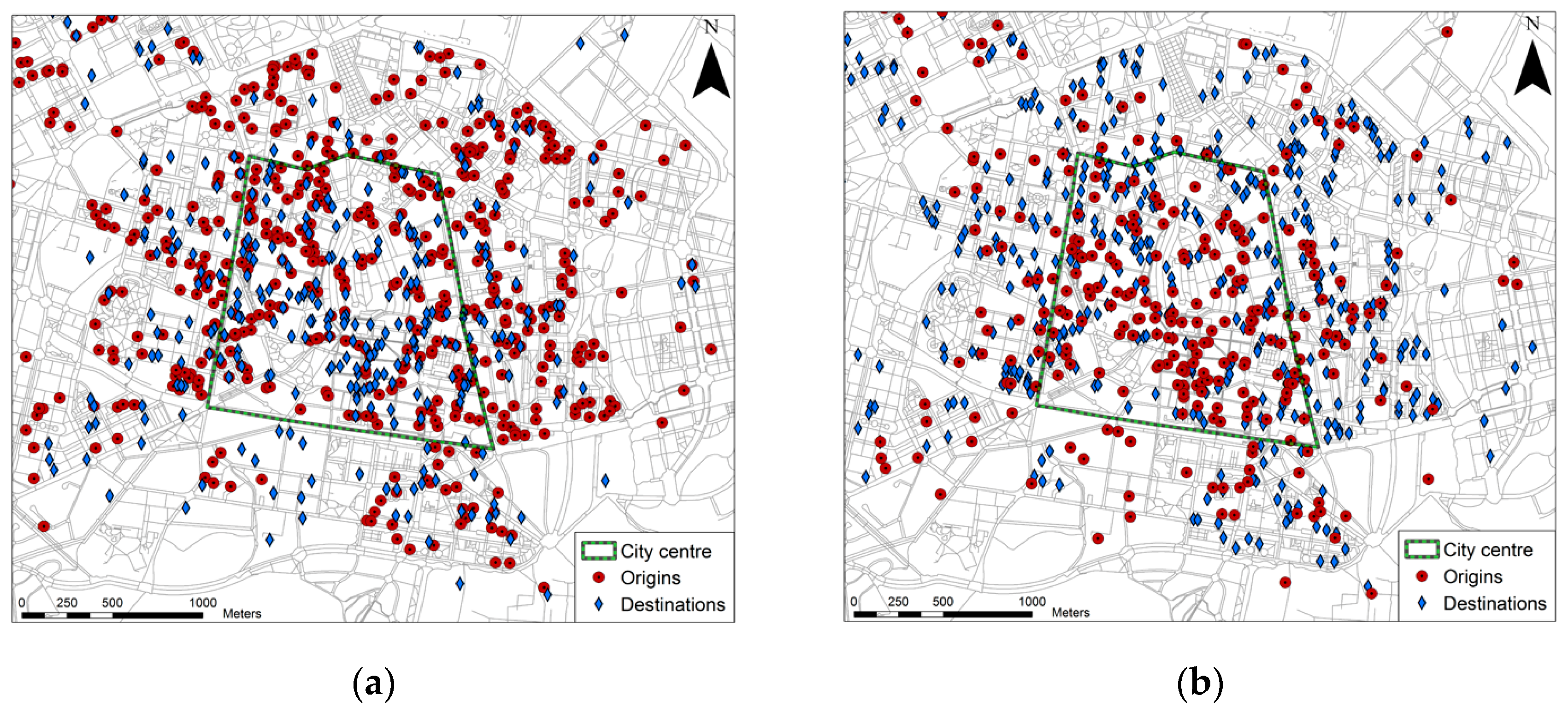
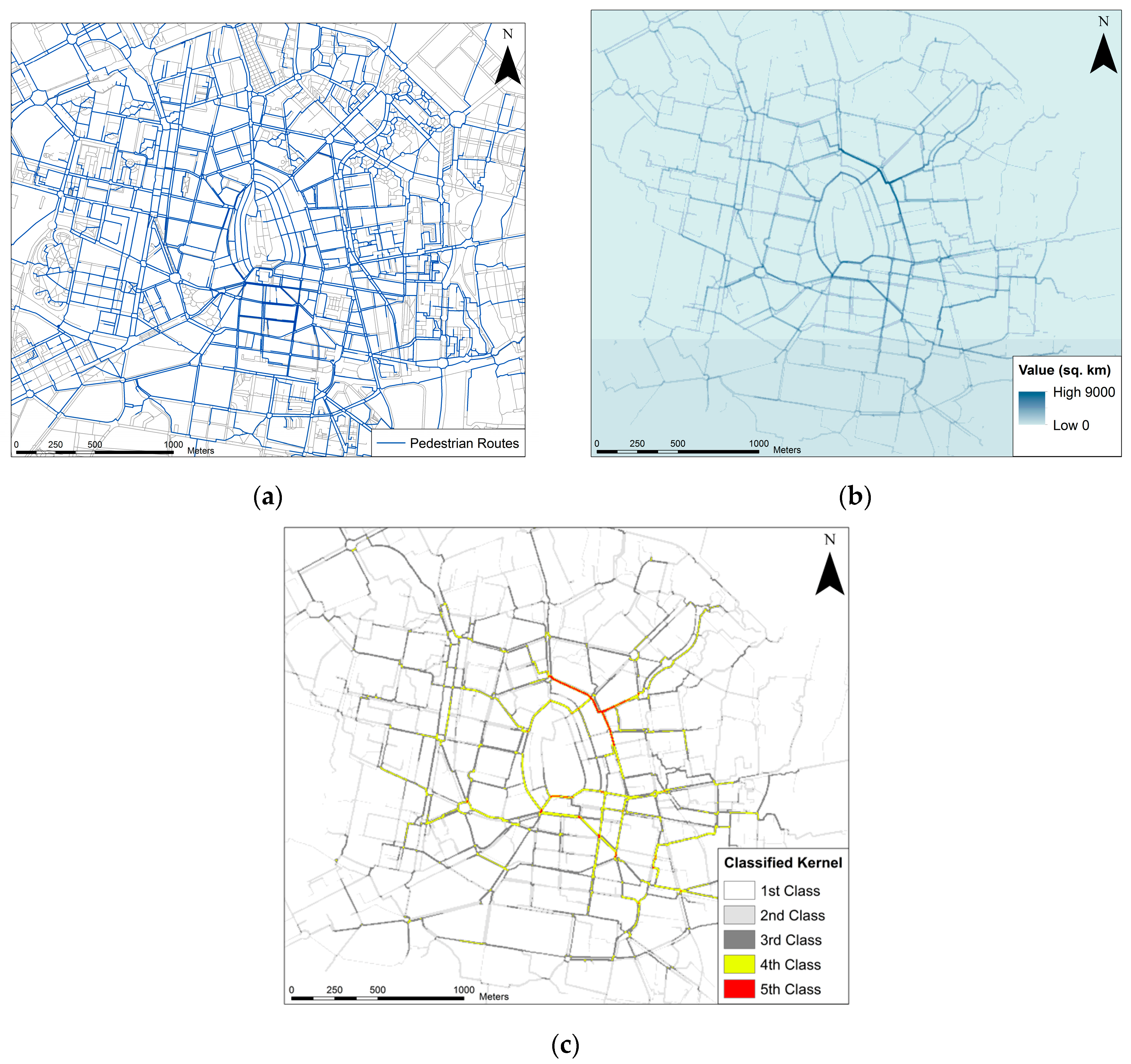
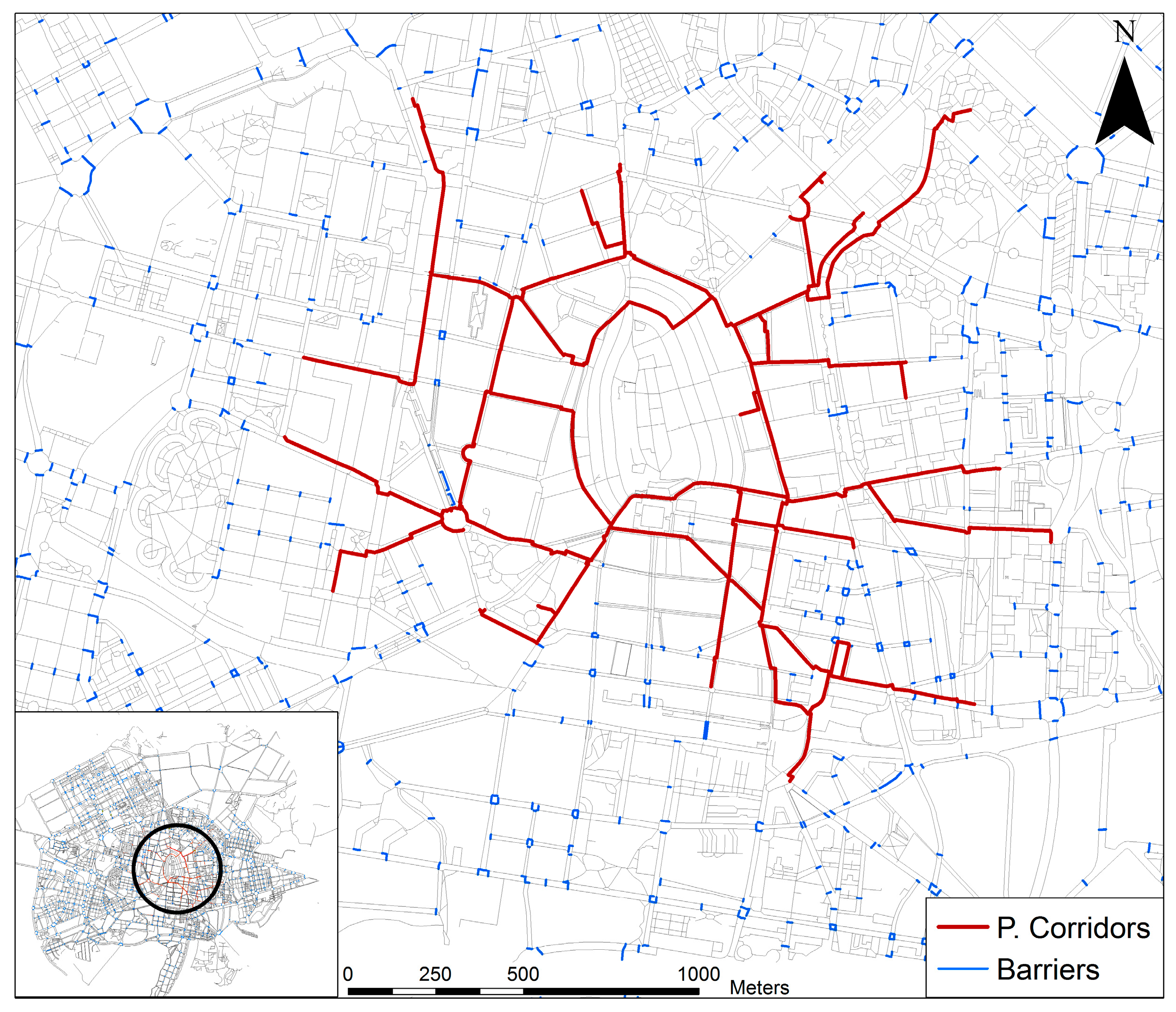
| Number of Barriers | Barriered Network (Scenario A) | Corridor Network (Scenario B) | Difference (No.) | Difference (%) |
|---|---|---|---|---|
| Crosswalks | 1474 | 1398 | 76 | 5 |
| Pedestrian crossings with traffic lights | 656 | 525 | 131 | 20 |
| Total | 2130 | 1923 | 207 | 10 |
| Outward Routes (702) | Barrier-Free Network (Scenario 0) | Barriered Network (Scenario A) | Corridor Network (Scenario B) | Declared Time Average |
|---|---|---|---|---|
| Average distance (m) | 1162 | 1181 | 1173 | - |
| Average time (min) | 17.61 | 19.69 | 18.45 | 15.10 |
| Difference with scenario 0 (%) | 11.85 | 4.77 | ||
| Difference with scenario A (%) | −6.32 |
| Return Routes (640) | Barrier-Free Network (Scenario 0) | Barriered Network (Scenario A) | Corridor Network (Scenario B) | Declared Time Average |
|---|---|---|---|---|
| Average distance (m) | 1178 | 1196 | 1188 | - |
| Average time (min) | 17.93 | 20.03 | 18.68 | 18.19 |
| Difference with scenario 0 (%) | 11.71 | 4.14 | ||
| Difference with scenario A (%) | −6.78 |
| Outward Routes (519, 720) | Barrier-Free Network (Scenario 0) | Barriered Network (Scenario A) | Corridor Network (Scenario B) |
|---|---|---|---|
| Average distance (m) | 1797 | 1829 | 1817 |
| Average time (min) | 27.22 | 30.48 | 28.52 |
| Difference with scenario 0 (%) | 11.98 | 4.78 | |
| Difference with scenario A (%) | −6.42 |
| Return Routes (428, 829) | Barrier-Free Network (Scenario 0) | Barriered Network (Scenario A) | Corridor Network (Scenario B) |
|---|---|---|---|
| Average distance (m) | 1826 | 1858 | 1846 |
| Average time (min) | 27.66 | 30.94 | 28.97 |
| Difference with scenario 0 (%) | 11.86 | 4.74 | |
| Difference with scenario A (%) | −6.37 |
| Mean Travel Time (min) | Coefficient of Variation (%) | |
|---|---|---|
| Outward | 19.13 | 0.25 |
| Return | 19.46 | 0.26 |
© 2017 by the authors. Licensee MDPI, Basel, Switzerland. This article is an open access article distributed under the terms and conditions of the Creative Commons Attribution (CC BY) license ( http://creativecommons.org/licenses/by/4.0/).
Share and Cite
Delso, J.; Martín, B.; Ortega, E.; Otero, I. A Model for Assessing Pedestrian Corridors. Application to Vitoria-Gasteiz City (Spain). Sustainability 2017, 9, 434. https://doi.org/10.3390/su9030434
Delso J, Martín B, Ortega E, Otero I. A Model for Assessing Pedestrian Corridors. Application to Vitoria-Gasteiz City (Spain). Sustainability. 2017; 9(3):434. https://doi.org/10.3390/su9030434
Chicago/Turabian StyleDelso, Javier, Belén Martín, Emilio Ortega, and Isabel Otero. 2017. "A Model for Assessing Pedestrian Corridors. Application to Vitoria-Gasteiz City (Spain)" Sustainability 9, no. 3: 434. https://doi.org/10.3390/su9030434
APA StyleDelso, J., Martín, B., Ortega, E., & Otero, I. (2017). A Model for Assessing Pedestrian Corridors. Application to Vitoria-Gasteiz City (Spain). Sustainability, 9(3), 434. https://doi.org/10.3390/su9030434








